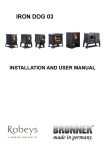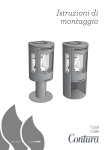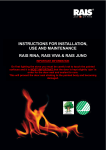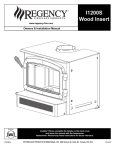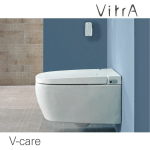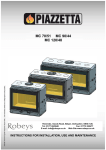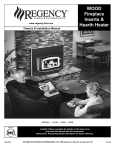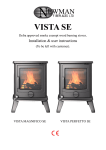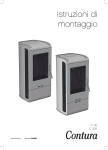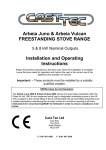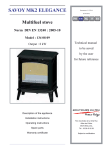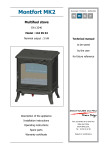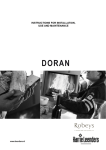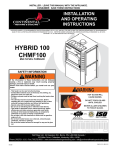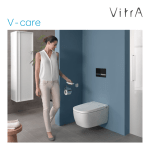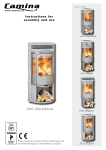Download user manual for stoves without boilers supplementary
Transcript
811142 BAV GB-7 March 2014 USER MANUAL FOR STOVES WITHOUT BOILERS SUPPLEMENTARY INSTALLATION INSTRUCTIONS FOR THE UK MARKET TO BE READ IN CONJUNCTION WITH THOSE IN THE INSTRUCTION BOOKLET READ THE INSTRUCTION BOOKLET AND THESE SUPPLEMENTARY INSTRUCTIONS CAREFULLY BEFORE INSTALLATION These instructions together with those in the instruction booklet cover the basic principles to ensure the satisfactory installation of the stove, although detail may need slight modification to suit particular local site conditions. In all cases the installation must comply with current Building Regulations, Local Authority Byelaws and other specifications or regulations as they affect the installation of the stove. It should be noted that the Building Regulations requirements may be met by adopting the relevant recommendations given in British Standards BS 8303, BS EN 15287-1:2007 as an alternative means to achieve an equivalent level of performance to that obtained following the guidance given in Approved Document J. Should any conflict apply between these instructions and the original manufacturers instructions then the most stringent advice must apply. Please note that it is a legal requirement under England and Wales Building Regulations that the installation of the stove is either carried out under Local Authority Building Control approval or is installed by a Competent Person registered with a Government approved Competent Persons Scheme. HETAS Ltd operate such a Scheme and a listing of their Registered Competent Persons can be found on their website at www.hetas.co.uk. CO Alarms:Building regulations require that when ever a new or replacement fixed solid fuel or wood/biomass appliance is installed in a dwelling a carbon monoxide alarm must be fitted in the same room as the appliance. Further guidance on the installation of the carbon monoxide alarm is available in BS EN 50292:2002 and from the alarm manufacturer’s instructions. Provision of an alarm must not be considered a substitute for either installing the appliance correctly or ensuring regular servicing and maintenance of the appliance and chimney system. 811142 BAV GB-7 March 2014 HEALTH AND SAFETY PRECAUTIONS Special care must be taken when installing the stove such that the requirements of the Health and Safety at Work Act are met. Handling Adequate facilities must be available for loading, unloading and site handling. Fire Cement Some types of fire cement are caustic and should not be allowed to come into contact with the skin. In case of contact wash immediately with plenty of water. Asbestos This stove contains no asbestos. If there is a possibility of disturbing any asbestos in the course of installation then please seek specialist guidance and use appropriate protective equipment. Metal Parts When installing or servicing this stove care should be taken to avoid the possibility of personal injury. STOVE PERFORMANCE Refer to the manufacturer’s main instruction manual for details of the stove’s performance. PREPARATORY WORK AND SAFETY CHECKS IMPORTANT WARNING This stove must not be installed into a chimney that serves any other heating appliance. There must not be an extractor fan fitted in the same room as the stove as this can cause the stove to emit fumes into the room. 811142 BAV GB-7 March 2014 Chimney In order for the stove to perform satisfactorily the chimney height must be sufficient to ensure an adequate draught of approximately 15 Pa so as to clear the products of combustion and prevent smoke problems into the room. NOTE: A chimney height of not less than 4.5 metres measured vertically from the outlet of the stove to the top of the chimney should be satisfactory. Alternatively the calculation procedure given in EN 13384-1 may be used as the basis for deciding whether a particular chimney design will provide sufficient draught. BS EN 15287-1:2007 gives additional details. The outlet from the chimney should be above the roof of the building in accordance with the provisions of Building Regulations Approved Document J. If installation is into an existing chimney then it must be sound and have no cracks or other faults which might allow fumes into the house. Older properties, especially, may have chimney faults or the cross section may be too large i.e. more than 230 mm x 230 mm. Remedial action should be taken, if required, seeking expert advice, if necessary. If it is found necessary to line the chimney then a flue liner suitable for solid fuel must be used in accordance with Building Regulations Approved Document J. Any existing chimney must be clear of obstruction and have been swept clean immediately before installation of the stove. If the stove is fitted in place of an open fire then the chimney should be swept one month after installation to clear any soot falls which may have occurred due to the difference in combustion between the stove and the open fire. If there is no existing chimney then any new system must be to the designation described above and in accordance with Building Regulations Approved Document J. A single wall metal fluepipe is suitable for connecting the stove to the chimney but is not suitable for use as the complete chimney. The chimney and connecting fluepipe must have a minimum diameter of 150 mm and its dimension should be not less than the size of the outlet socket of the stove. Any bend in the chimney or connecting fluepipe should not exceed 45°. 90° bends should not be used. 811142 BAV GB-7 March 2014 Combustible material should not be located where the heat dissipating through the walls of fireplaces or flues could ignite it. Therefore when installing the stove in the presence of combustible materials due account must be taken of the guidance on the separation of combustible material given in Building Regulations Approved Document J and also in these stove instructions. If it is found that there is excessive draught in the chimney then a draught stabiliser should be fitted. Fitting of a draught stabiliser will affect the requirement for the permanent air supply into the room in which the stove is fitted in accordance with Approved Document J (see also combustion air supply). Adequate provision e.g. easily accessible soot door or doors must be provided for sweeping the chimney and connecting fluepipe where it is not intended for the chimney to be swept through the appliance. Hearth The hearth should be level and able to accommodate the weight of the stove and its chimney if the chimney is not independently supported. The weight of the stove is indicated in the brochure. The stove should preferably be installed on a non-combustible hearth of a size and construction that is in accordance with the provisions of the current Building Regulations Approved Document J. The clearance distances to combustible material beneath, surrounding or upon the hearth and walls adjacent to the hearth should comply with the guidance on the separation of combustible material given in Building Regulations Approved Document J and also in these stove instructions. If the stove is to be installed on a combustible floor surface, it must be covered with a non-combustible material at least 12mm thick, in accordance with Building Regulations Approved Document J, to a distance of 30 cm in front of the stove and 15 cm to each side measuring from the door of the combustion chamber. 811142 BAV GB-7 March 2014 Combustion air supply In order for the stove to perform efficiently and safely there must be an adequate air supply into the room in which the stove is installed to provide combustion air. The provision of air supply to the stove must be in accordance with current Building Regulations Approved Document J. Special attention should be taken in newer build properties where the design air permeability is less than 5m3/h.m2. Approved Document J gives more information on this. An opening window is not appropriate for this purpose. The fitting of an external air kit direct to outside air must not be considered substitute for installing the appliance with a permanently open air vent in compliance with ventilation requirements stated in Approved Document J. Please reference ADJ for further guidance. Connection to chimney Stoves may have a choice of either a rear or top flue gas connector that allows connection to either a masonry chimney or a prefabricated factory made insulated metal chimney in accordance with their instructions. In some cases it may be necessary to fit an adaptor to increase the diameter of the flue to the minimum required 150 mm section of the chimney or liner. All joints in the connection between the stove and the chimney must be made gastight using fire cement and where necessary fire-proof rope infill. Means should be made for sweeping the entire length of the flue, be that through the appliance or by suitable sweeping hatch in the flue. Commissioning and handover Ensure all parts are fitted in accordance with the instructions. On completion of the installation allow a suitable period of time for any fire cement and mortar to dry out, before lighting the stove. Once the stove is under fire check all seals for soundness and check that the flue is functioning correctly and that all products of combustion are vented safely to atmosphere via the chimney terminal. On completion of the installation and commissioning ensure that the operating instructions for the stove are left with the customer. Ensure to advise the customer on the correct use of the appliance and warn them to use only the recommended fuel for the stove. Advise the user what to do should smoke or fumes be emitted from the stove. The customer should be warned to use a fireguard to BS 8423:2002 (Replaces BS 6539) in the presence of children, aged and/or infirm persons. 811142 BAV GB-7 March 2014 HETAS Ltd Approval; These appliances have been approved by HETAS Ltd as an intermittent operating appliance for burning wood logs only. WARNING NOTE Properly installed, operated and maintained this stove will not emit fumes into the dwelling. Occasional fumes from de ashing and re fuelling may occur. However, persistent fume emission is potentially dangerous and must not be tolerated. If fume emission does persist, then the following immediate action should be taken: (a) Open doors and windows to ventilate the room and then leave the premises. (b) Let the fire go out. (c) Check for flue or chimney blockage and clean if required (d) Do not attempt to relight the fire until the cause of the fume emission has been identified and corrected. If necessary seek expert advice. The most common cause of fume emission is flueway or chimney blockage. For your own safety these must be kept clean at all times. IMPORTANT NOTES General Before lighting the stove check with the installer that the installation work and commissioning checks described above have been carried out correctly and that the chimney has been swept clean, is sound and free from any obstructions. As part of the stoves’ commissioning and handover the installer should have shown you how to operate the stove correctly. 811142 BAV GB-7 March 2014 CO Alarm Your installer should have fitted a CO alarm in the same room as the appliance. If the alarm sounds unexpectedly, follow the instructions given under “Warning Note” above. Air Controls Manually operated air control can be managed by adjusting the air control valve to increase/decrease the air flow to the stove. Use of fireguard When using the stove in situations where children, aged and/or infirm persons are present a fireguard must be used to prevent accidental contact with the stove. The fireguard should be manufactured in accordance with BS 8423:2002. Chimney cleaning The chimney should be swept at least twice a year. It is important that the flue connection and chimney are swept prior to lighting up after a prolonged shutdown period. If the stove is fitted in place of an open fire then the chimney will require sweeping after a month of continuous operation. This is a precaution to ensure that any “softer” deposits left from the open fire usage have not been loosened by the higher flue temperatures generated by the closed stove. In situations where it is not possible to sweep through the stove the installer will have provided alternative means, such as a soot door. After sweeping the chimney the stove flue outlet and the flue pipe connecting the stove to the chimney must be cleaned with a flue brush. Periods of Prolonged Non-Use If the stove is to be left unused for a prolonged period of time then it should be given a thorough clean to remove ash and unburned fuel residues. To enable a good flow of air through the appliance to reduce condensation and subsequent damage, leave the air controls fully open. Extractor fan There must not be an extractor fan fitted in the same room as the stove as this can cause the stove to emit smoke and fumes into the room. 811142 BAV GB-7 March 2014 Aerosol sprays Do not use an aerosol spray on or near the stove when it is alight. Use of operating tools Always use the operating tools provided when handling parts likely to be hot when the stove is in use. Chimney Fires If the chimney is thoroughly and regularly swept, chimney fires should not occur. However, if a chimney fire does occur turn off the stove immediately and isolate the mains electricity supply (if applicable), and tightly close the doors of the stove. This should cause the chimney fire to go out. If the chimney fire does not go out when the above action is taken then the fire brigade should be called immediately. Do not relight the stove until the chimney and flueway have been cleaned and examined by a professional. Permanent air vent The stove requires a permanent and adequate air supply in order for it to operate safely and efficiently. In accordance with current Building Regulations the installer may have fitted a permanent air supply vent into the room in which the stove is installed to provide combustion air. This air vent should not under any circumstances be shut off or sealed. USER OPERATING INSTRUCTIONS Please read the important notices given above before referring to the main instruction book for detailed operating instructions. Recommended fuels: Please note that HETAS Ltd Appliance Approval only covers the use of wood logs on this appliance. HETAS Ltd Approval does not cover the use of other fuels either alone or mixed with the recommended fuels listed above, nor does it cover instructions for the use of other fuels. The stoves have a refuelling interval of 0.75h to achieve the nominal rated output. Wood logs should be seasoned with a moisture content of around 20%. 811142 BAV GB-7 March 2014 Refuelling on to a low fire bed: If there is insufficient burning material in the firebed to light a new fuel charge, excessive smoke emission can occur. Refuelling must be carried out onto a sufficient quantity of glowing embers and ash that the new fuel charge will ignite in a reasonable period. If there are too few embers in the fire bed, add suitable kindling to prevent excessive smoke. Fuel overloading: The maximum amount of fuel specified in this manual should not be exceeded, overloading can cause excess smoke. Operation with door left open: Operation with the door open can cause excess smoke. The appliance must not be operated with the appliance door left open except as directed in the instructions. THE CLEAN AIR ACT 1993 AND SMOKE CONTROL AREAS Under the Clean Air Act local authorities may declare the whole or part of the district of the authority to be a smoke control area. It is an offence to emit smoke from a chimney of a building, from a furnace or from any fixed boiler if located in a designated smoke control area. It is also an offence to acquire an ”unauthorised fuel” for use within a smoke control area unless it is used in an ”exempt” appliance (”exempted” from the controls which generally apply in the smoke control area). The Secretary of State for Environment, Food and Rural Affairs has powers under the Act to authorise smokeless fuels or exempt appliances for use in smoke control areas in England. In Scotland and Wales this power rests with Ministers in the devolved administrations for those countries. Separate legislation, the Clean Air (Northern Ireland) Order 1981, applies in Northern Ireland. Therefore it is a requirement that fuels burnt or obtained for use in smoke control areas have been ”authorised” in Regulations and that appliances used to burn solid fuel in those areas (other than ”authorised” fuels) have been exempted by an Order made and signed by the Secretary of State or Minister in the devolved administrations. Further information on the requirements of the Clean Air Act can be found here : http://smokecontrol.defra.gov.uk/ Your local authority is responsible for implementing the Clean Air Act 1993 including designation and supervision of smoke control areas and you can contact them for details of Clean Air Act requirements 811142 BAV GB-7 March 2014 Appliance Exemption: The Contura 500, 700, i4, i5, i30 and i40 series are recommended as exempt appliances under the Clean Air Act 1993 when burning dry seasoned wood logs in accordance with the instructions and when fitted with the permanent stops detailed below: The Contura 500 series must be fitted with a mechanical stop to prevent closure of the air control vent beyond the 20% open position when sold into smoke control areas. The Contura 700 series must be fitted with a mechanical stop to prevent closure of the air control vent beyond the 28% open position when sold into smoke control areas. The Contura i4 series must be fitted with a mechanical stop to prevent closure of the air control vent beyond the 30% open position when sold into smoke control areas. The Contura i5 series must be fitted with a mechanical stop to prevent closure of the air control vent beyond the 30% open position when sold into smoke control areas. The Contura i30 and i40 series must be fitted with a mechanical stop to prevent closure of the air control vent beyond the 27% open position when sold into smoke control areas. 811142 BAV GB -7 2014-03-03 NIBE AB · Box 134 · 285 23 Markaryd · Sweden www.contura.eu Installation instructions C 790T www.contura.eu GB CERTIFICATE EC Declaration of conformity www.contura.eu Manufacturer name address Place of manufacture NIBE AB/NIBE STOVES Box 134, Skulptörvägen 10, SE-285 23 Markaryd Markaryd, Sweden PrODuct Product type type designation Standard Intended for use fuels Special conditions Stove fired by solid fuel Contura 790T EN 13240 annex ZA Heating of living accommodation Wood logs None ce-MarKInG Issued nominal output fuel type flue gas temperature energy efficiency emission of cO 2012 5 kW Wood logs 271° C 80% 0,1% appendix Lighting and installation instructions Niklas Gunnarsson Business area manager NIBE STOVES Manufacturer's declaration The stove is approved by the Swedish National Testing and Research Institute, SP SITAC. The stove fulfils the applicable rules for CE labelling. Manufacture of the product has taken place in accordance with those documents that are the basis for the relevant type approval certification and the required manufacturing checks. 378 OR DIC ECOLA Contura 790T is a Swan marked wood burning stove. B EL N 82 001 NIBE was the first stove manufacturer in Sweden to commit to Swan labelling their stoves. The Swan label is one aspect of our vision to be a company of the future, setting high quality standards regarding the environment. Certification number 378-001. GB CONTENTS A warm welcome to Contura. A warm welcome to the Contura family. We hope you will get a great deal of pleasure from your new stove. As a new owner of a Contura stove, you have secured a product with timeless design and long service life. Contura also has a combustion process that is both environmentally friendly and efficient, for the best heat production. Read through these installation instructions carefully before installation. Read how to best light your stove in the lighting instructions. List of Contents Technical details84 Prior to installation 84 Connection to chimney 85 Supply of combustion air/Option 86 Installation distances87 Installing heat tank stone 88 Installing suspension profiles 91 Installing the soapstone 94 Installing heat tank stone on top 96 Removing the loose parts 98 Installing the base door 99 NOTE: WARNING! Report the installation of a stove to your local authority. The stove becomes very hot The owner of the house is personally responsible for ensuring compliance with the mandatory safety requirements and must have the installation approved by a qualified inspector. Your local chimney sweep must also be informed about the installation as this will affect the routines for regular chimneysweeping services. During operation, certain surfaces of the stove become very hot and can cause burn injuries if touched. Also, take heed of the strong heat radiated through the door glass. Placing flammable material closer than the safe distance indicated may cause a fire. Smoulder combustion can cause quick gas ignition with the risk of damage to property and personal injury. 83 GB 84 FACTS Technical details Important to remember! Effect3-7kW Nominal effect 5 kW Efficiency up to 80% Installation by authorised technician This manual contains instructions about how the stove must be assembled and installed. To ensure the function and safety of the stove, we recommend that the installation is carried out by an authorised technician. Contact one of our dealers who can recommend suitable fitters. Model790T Height (mm) 1593 Width (mm) 556 Depth (mm) 407 Weight (kg) 260 Stone heat tank (kg) 65 Type approved in accordance with: European standard EN-13240 Swedish type approval SITAC SC 0307-11 Norwegian standard NS 3059, SINTEF - 110-0354 German standard DIN Plus, RRF - 40 12 3047 Building application These main instructions may give guidance which would contravene national building regulations. Please refer to supplementary instructions or ask your local authority for advice regarding building regulations. Before installing a stove or erecting a chimney it is necessary for you to make a building permission application to your local authority. Prior to installation If the insert needs to be put down to be moved, loose components should be removed. When the stove is installed reinstall the components in reverse order. 1 Fire bars 2 Grate disc 3 Heat deflector 4 Fire bricks Structural support Check that the wood joists are strong enough to bear the weight of the stove and chimney. The stove and chimney can usually be placed on a normal wooden joist in a single occupancy house, if the total weight does not exceed 400 kg. Floor plate Due to the risk of falling embers, a flammable floor must be protected by a hearth plate. It must extend 300 mm in front of the stove and 100 mm on each side of the stove, or have a 200 mm extension on each side of the opening. The hearth plate can consist of natural stone, concrete, metal plate or glass. A painted metal or glass hearth plate is available as an accessory for these models. 4 1 2 3 GB CHIMNEY Connection to chimney • The stove meets the requirements for connecting to chimneys dimensioned for 350°C flue gas temperature. • The external diameter of the connection sleeve is 150 mm. • The stove requires a draft in the chimney of at least –12 Pa. The draft is affected both by the length and area of the chimney, and by how well sealed it is. The minimum recommended chimney length is 3.5 m and suitable cross sectional area is 150-200 cm² (140-160 mm in diameter). • A flue with sharp bends and horizontal routing reduces the draught in the chimney. The maximum horizontal flue is 1 m, on the condition that the vertical flue length is at least 5 m. • It must be possible to sweep the full length of the flue and the soot doors must be easily accessible. • Carefully check that the chimney is sealed and that there is no leakage around soot doors and flue connections. In the bag with these installation instructions are two wing screws for the lid. Rear connection to a masonry chimney The back panel must be installed before the stove is rear connected. Ø ca 180 mm 1 Ø ca 180 mm 4 2 3 5 6 Top connection to the chimney The hot air grille must be installed before chimney top connection. ! Make sure that the connector gasket does not work loose when the connection pipe is placed on the connector. If further sealing material is required, heat-resistant sealant may be used. 85 GB SUPPLY AIR/ACCESSORY Supply of combustion air When a stove is installed in a room, the demand for air supply to the room increases. Air can be provided indirectly via a vent in the outer wall or via a duct from the outside that is connected to the connector on the underneath of the stove. The amount of air needed for combustion is approx. 15m3/h. The connector has an external diameter of 67 mm. When duct routing further than 1 m the pipe diameter must be increased to 100 mm and a correspondingly larger wall vent must be selected. In hot areas the duct should be insulated with 30 mm mineral wool covered with a moisture inhibitor (plastic). It is important that the lead-in between the pipe and the wall (or floor) is sealed using jointing compound. In the back and floor plates there are knockouts that must be removed to insert the pipe. A 1 m length of condensation-insulated ducting for combustion air is available as an accessory. Leave a 40 mm gap between the condensation insulation and the bottom of the stove. 40 mm ! Installation variants HK HK Through floor and wall-and-cavity foundation. 40 mm Indirect air supply through the external wall. 40 mm 86 HK HK Through the external wall. Through floor and foundation slab. GB INSTALLATION DISTANCES Installation distances C 790T Combustible roof The minimum distance in front of the stove opening to combustible parts of the building or interior decoration must be at least 1 m. The dimension diagrams only show the minimum permitted installation distances for the stove. When connecting to a steel flue, also note the safety distance requirements of the flue. The safety distance between an uninsulated flue and a combustible part of the building should be at least 300 mm. 407 211 556 2300* Ø150 72 B 1180* height from floor to chimney connection upwards height from floor to c/c chimney connection rear height from floor to air inlet height from floor to lower edge of hatch B= C= D 588 C 574 A 1270* 1593 A= D= 139 Air inlet Ø67 900 900 593 643 311 361 50** Fire-retardant wall of brick or concrete 100 Combustible wall 63 7 6 70 100 Fire-retardant wall of brick or concrete 479 261 1100 479 311 Combustible wall 50** 700 100 Permitted area for combustible parts of the building ! 400 678 200** A separate glass hearth plate (accessory) increases the connection height to the chimney by 10 mm. 478 * If the stove is placed on a hearth plate made of glass for example (accessory), the height from the floor is affected by a distance corresponding to the thickness of the hearth plate. Also applies to separate glass hearth plates (accessory). ** To prevent discolouration of painted non-flammable walls we recommend that the same side distance as to combustible walls is used. 87 GB 88 ASSEMBLY Installing heat tank stone If the stove cannot be equipped with the heat tank stone, advance to page 90 1 x5 10 No. 7 CHROME VANADIUM 10 3 2 GB ASSEMBLY 4 5 1 2 6 90° 89 GB 90 ASSEMBLY ! GB ASSEMBLY Installing suspension profiles 2 10 1 3 No. 7 CHRO ME VANADIU M 10 91 2 10 UM ADI No. 7 ME VAN RO CH 10 92 1 90° 5 4 ASSEMBLY GB GB ASSEMBLY 6 7 8 93 GB 94 ASSEMBLY Installing the soapstone 1 2 3 GB ASSEMBLY 4 5 6 95 GB 96 ASSEMBLY Installing heat tank stone on top 1 2 3 4 GB ASSEMBLY 5 6 Final inspection of the installation It is extremely important that the installation is inspected by an authorised chimney sweep before the stove is used. Also read the "Lighting instructions" before lighting for the first time. 97 GB 98 REMOVAL Removing the loose parts How to remove the heat deflector How to remove the firebricks Handle the vermiculite with care. Lift the smoke baffle with one hand whilst removing the sides. The side posts need not be removed when sweeping. Reinstall in reverse order 1 3 2 GB ASSEMBLY Installing the base door 1 2 3 99 NIBE AB · Box 134 · SE-285 23 Markaryd · Sweden www.contura.eu 811167 IAV SE-EX C790T-3 2012-06-21 Contura reserves the right to change colours, materials, dimensions and models at any time without special notice. Your dealer can give you the most up to date information. Stoves shown in brochures may have extra equipment. Lighting Instructions C 750 C 780 www.contura.eu GB Lighting Instructions 18 Lighting in the right way It is important that the correct amount of wood is used, especially when lighting. If you are lighting the fire for the first time you should use a set of scales to see how much 2.0 kg kindling is. Also check what the normal and maximum weights look like. The stove may only be lit with the hatch closed. Always open the hatch carefully and slowly to prevent blow back because of the changing pressure in the stove. The function of the stove differs depending on the draft conditions in the chimney. Achieving the correct setting for the combustion air damper, suitable size and amount of wood usually takes a few attempts. Correctly sized wood Note that if too little kindling is used when lighting, or if the wood is too thickly cut, the firebox will not reach the correct operating temperature. Incorrect lighting can lead to poor combustion with heavy sooting and may result in the fire going out when the hatch is shut. Lighting If the house has mechanical ventilation, open a window near to the fireplace prior to lighting. Leave the window open for a few minutes until the fire has caught properly. NOTE! The left hand handle that controls the grate disc must be closed during lighting. 1. Open the control for the combustion air fully. 2. Insert paper or firelighters and about 2.0 kg of thinly chopped kindling into the firebox. Stack the wood crosswise. 3. Light the fire. 4. Set the hatch to the lighting position, that is with the lower hook against the lock roller to create a sufficient gap (see figure). 5. When the fire has caught fully after approx 5-10 minutes, close the hatch completely. 6. A slight amount of soot may build up on side glass during the start-up fire. This is normal and vanishes after a period. 7. A fresh load of logs should not be put on until the start-up fire has become a glowing bed of embers. Kindling: Finely chopped wood Length: 25-30 cm Diameter: 2 - 5 cm Amount per firing: 2.0 kg (approx. 10-12 finely chopped pieces) Feeding Wood: Chopped wood Length: 25-30 cm Diameter: 7 - 9 cm Normal amount: 1.3 kg/hour (2 pieces) Max amount: 2.4 kg/hour (max 3 pieces per insertion. Max 1.8 kg per insertion) Important! It is important that the wood catches fire quickly. Quick lighting is achieved by opening the combustion air damper fully or by leaving the hatch ajar for a moment. Pyre lighting produces a lot of smoke and can cause quick gas ignition in the worst instance resulting in hearth damage. Adding wood 1. Open the hatch a few centimetres and allow the vacuum in the firebox to equalise for a few seconds before opening the hatch fully. 2. Add 2-3 logs of a combined weight of approx 1.2–1.5 kg. Lay the logs diagonally on each other so that the flame can take easily. Then close the hatch. 3. The combustion damper must be completely open for 3-5 minutes or until the logs turn black and catch fire. If slower combustion is then required, the supply of combustion air can be reduced. The conditions for controlling combustion vary depending on the temperature in the firebox and the draft in the chimney. 4. An average energy output of 5 kW is achieved when the combustion air damper is 40% open and 2 logs weighing about 1.3-1.5 kg are added once per hour. 5. The lowest output of 3-4 kW is obtained when the combustion air damper is 30% open. In this operating position it is important that the combustion air damper is fully open for the first 3-5 minutes so that the wood has time to ignite properly before the supply of combustion air is reduced. A condition for regulating the output is a thick bed of embers and high temperature in the firebox. When the fire has died down to embers more wood should be added. Lighting Instructions GB 19 Choosing fuel When the stove is new All types of wood, such as birch, beech, oak, elm, ash, conifers and fruit trees can be used as fuel in the stove. Different types of trees have different densities, the greater the density of the wood the greater the energy value. Oak, beech and birch have the highest density. When new, the stove may emit an odour due to excess paint and oil coating that may remain on the panels. The odour will disappear completely after several fires. The wood’s moisture content Fresh wood is about 50 per cent water. Some of the water circulates freely between the fibres and some of the water is bound in the cells. The wood must always be dried so that the free water evaporates. The timber is ready for use when the moisture content has fallen below 20%. If wood with a higher moisture content is lit, a large part of the energy content of the wood is used boiling off the water. If the wood is damp, the combustion is also poor, layers of soot and tar build up in the chimney and could, at worst, lead to a chimney fire. In addition, it causes the glass of the stove to soot and may cause discomfort to those living nearby. To ensure thoroughly dry wood, the wood should be cut in the winter and stored, well aired, under a roof. Never cover the woodpile with a tarpaulin to the ground. The tarpaulin will then act as a sealed cover and the wood will be prevented from drying. Always store a small amount of wood indoors for several days before use, so that the surface moisture has time to evaporate. Do NOT burn the following Under no circumstances may pressure impregnated wood, painted or glued wood, chipboard, plastic or colour brochures be used as fuel in a hearth. All these materials can create hydrochloric acid and heavy metals that are damaging both to the environment and the hearth. Hydrochloric acid can also attack the steel in the chimney or the mortar in a stone built chimney. Also avoid using bark, woodchips or other extremely finely chopped wood except for lighting. Fuel of this type causes flashover resulting in too high output. Not too big fires Fires should not be too big. Large fires are uneconomical and they give off high flue gas temperatures that can damage the stove and the environment. Recommended amount of wood for normal use is 1.3 kg/hour, with the maximum permitted amount of 2.4 kg/hour and covers lighting with chopped birch wood or other broad leaf wood with a moisture content of about 18%. When lighting with the same wood amounts as above but with, for example, conifer wood, higher fireplace temperatures are achieved. The service life of the stove can be cut short if the fire is left at full combustion for long periods, and if the maximum permitted amount of wood is exceeded, parts in the stove can become damaged thus annulling the warranty. Maintaining the stove The glass may become sooty with use, even if the stove is lit with dry wood with a moisture content of 15 – 20%. Regular cleaning with dry paper is usually sufficient to keep it clean. If the soot has been on the glass for a prolonged period use a cleaning agent or a special soot removal agent to remove it. Such agents can be purchased from regular hardware stores or from your local stove dealer. Never use cleaning agents that contain any abrasives, these can damage the glass. • When emptying the ash-pan, ensure that there are no glowing embers. The ash must be stored in a fireproof container with a lid for at least one week before being disposed of. • The grate and other cast iron components in the firebox can be cleaned using a wire brush. • It is important from a combustion point of view to check gaskets, as worn gaskets hinder combustion when the stove draws “extra air”. • Painted parts on the stove can be cleaned using a damp cloth, with a small amount of detergent, if necessary. Damage to painted parts, e.g. small scratches, can be rectified with Contura touch-up paint. Contact your dealer. • As there is a constant large flow of air through the stove, as cold room air is drawn in and hot air released, dust can collect behind and under the stove. Therefore, the areas under and behind the stove should be regularly cleaned. • Parts located near the actual seat of the fire may require replacing. Examples of such parts are the hearth surround and grate. The service life of these parts depends on how much and how the stove is used. Hearth plate glass must be discarded as waste material together with pottery and porcelain GB Lighting Instructions 20 Possible causes of malfunctions and how to rectify them Poor draft in the stove after new installation • C heck the dimensions of the chimney so that they correspond to the ones stated in the installation instructions. • Check that there is nothing in the chimney to restrict the smoke and that no nearby buildings or trees affect the winds around the chimney. Abnormal amounts of soot form on the glass There is always a certain amount of soot on the glass and this is added to with each lighting. Soot on the glass is caused by three things: • The wood is damp, which causes poor combustion and generates a lot of smoke as a result. • Too low temperature in the firebox, which causes incomplete combustion and poor draft in the chimney. • Handling is not correct, for example the hatch was not in the lighting position for 5-10 min. Check the moisture content of the wood, ensure that you have good base embers and go through the lighting instructions one more time. Smoke odour around the stove for periods It is difficult to light the fire and the fire dies after a short time • Check that the wood is sufficiently dry. • Too great a negative pressure in the house, for example when using a kitchen extractor fan or other mechanical ventilation. Open a window near the hearth before lighting the fire. Also try lighting some newspaper and holding it up inside the firebox to get the draft going. • The supply air duct from outdoors can be partially or totally blocked. Remove the hose and try test lighting with combustion air from the room. • Check that the combustion air damper is open. • The smoke outlet of the stove may be blocked with soot, which can occur after sweeping. Lift the smoke baffle out and check. • Finally, go through the lighting instructions again. Perhaps the amount of kindling was too small and therefore the base embers were too weak and cold to light the next load of wood. This can occur when wind blows down the chimney and most often occurs when the wind is from a particular direction. Another reason could be that the hatch was opened when there was a lot of flame. Painted parts have become discoloured If painted parts have discoloured it is due to excessive temperature in the firebox. The reason for the excessive temperature can be that the maximum amount of wood has been used or that inappropriate fuel has been used (for example building waste, large quantities of finely chopped off cuts). The warranty does not cover damage of this type. If a problem occurs that you cannot rectify yourself, contact the dealer or a chimney sweep. We hope that these lighting tips give you enjoyable, economical and problem free use of your Contura stove. Sweeping Sweeping the chimney ducts and chimney connections should be carried out by a chimney sweep. Sweep the stove by scraping and/or brushing. A soot vacuum cleaner is most appropriate however. If a chimney fire occurs or is suspected, the combustion damper and the door must be closed. If necessary, contact the fire brigade to extinguish it. The chimney must always be inspected by a chimney sweep after a chimney fire. Warning • During operation, the surfaces of the stove become very hot and can cause burn injury if touched. • Be aware of the strong heat radiated through the hatch glass. • Placing flammable material closer than the safe distance indicated may cause a fire. • Pyre lighting can cause quick gas ignition with the risk of damage to property and personal injury. 811064 BAV SE-EX C750/780-3 2011-11-29 NIBE AB· Box 134 · 285 23 Markaryd · Sweden www.contura.eu Contura reserves the right to change dimensions and procedures described in these instructions at any time without special notice. The current edition can be downloaded from www.contura.eu






































